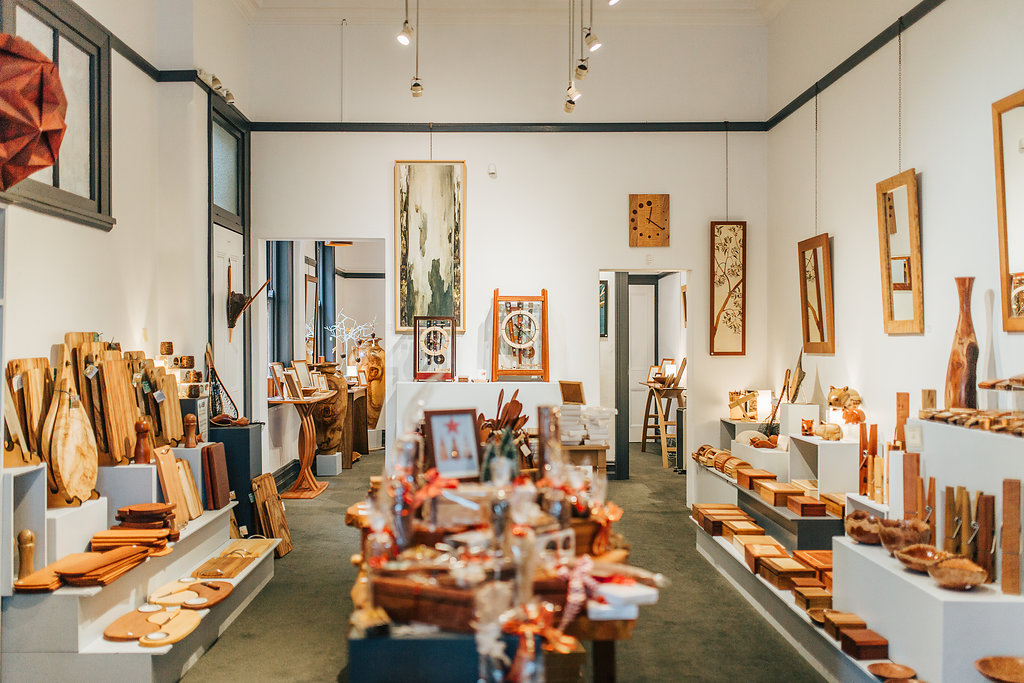Gallery ONE88 Fine Arts in Katoomba began as a pipedream for Sharon and Victor Peralta. It became a reality ten years later, in November 2015.
The concept was simple: to support and encourage established and emerging artists by providing an accessible exhibition space, providing positive experiences for creators, investors and admirers, and offering low commission rates.
The gallery houses numerous exhibition spaces on three floors. The building’s main advantage is its expansive west-facing double frontage, allowing ample natural light to flood the space and highlight the works on display. Pedestrians can preview the space from the street. The gallery is welcoming and inviting and its vast windows allow flexibility in how works are showcased.
“Because we have such a huge expanse of space, it allows us to hang works differently,” Sharon says. “There are paintings on the ceiling, coffee tables on the wall, hanging nests and canvases displayed in every corner from the basement to the rooftop.”
Sharon and Victor invested in standard LED lighting and are now upgrading to the newest LED lighting systems, specifically designed for gallery exhibitions and further reducing the gallery’s carbon footprint.
Paper waste is recycled or reused as drawing paper for young visitors and general waste is minimised as much as possible. Residual glass has been used by an artist to recreate four glass sculptures currently exhibited in the gallery window. Organic waste is composted at home.
The gallery also provides ‘boomerang bags’ for customers, and offers MTNS Made bags for sale. Bubble wrap use is minimised with art buyers encouraged to return packaging for reuse to avoid adding to landfill.
Gallery functions are catered with non-disposable cups, glassware and cutlery, and the Peraltas source food from local suppliers to prepare onsite (managing a family of nine has enabled the Peraltas to streamline food production without waste).
Because the building is leased, the Peraltas need owner’s approval to install a solar panel system. For Sharon: “It is all about being flexible. Reassessing where you are is important to keeping on top of new technologies and improving the service you provide to the public.” Gallery 188 is a Silver rated Low Carbon Living Program member.
Sharon is aware there is a decisive shift in the way artists are addressing the impacts of climate change. She says artists are becoming more creative with recycled materials and merging traditional techniques with new ones.
Leura Fine Woodwork Gallery has carved itself a niche in the heart of Leura Mall amongst specialised retailers, cafés and restaurants.
Leura’s shopping centre boasts a picturesque setting with four distinct seasons. This encourages visitors and locals to take their time and enjoy the near-extinct pastime known as ‘browsing’.
Judith Langley and Neil Williams bought Fine Woodwork Gallery in 2001. It was an established business showcasing high quality handcrafted, made-to-last wooden pieces that directly challenge our throwaway society.
As a former cabinet-maker, Neil Williams immediately saw the gallery’s potential to support and promote artists who give up their day job and devote their lives to creating distinctive works of art that would pass from one generation to the next.
Master clockmakers, innovative furniture designers, sculptors, carvers and fine woodcrafters are represented with unique works in the finest of Australian timbers. Few other galleries offer such a diverse range of craftsmanship and Neil is proud of his gallery’s reputation.
“When Judith and I began in the retail business we knew nothing about how to be retailers. Since then I’ve learned that good quality products, well-represented at reasonable prices and with friendly assistance are key elements that foster a successful business,” Neil enthuses.
Nurturing a sustainable business has its own challenges. Judith and Neil don’t own the building so they are limited in the modifications they can make. In 2001, Neil began replacing high wattage light bulbs with more energy- and cost-efficient ones. Now, all 30 light globes are 5watt LEDs. Recycled paper, cardboard and bubble wrap is used to transport items, and Neil manages two trips a month to the recycling centre in Katoomba. Low carbon initiatives in the future may include an investment in solar panels and a battery system already implemented at home.
Surprisingly, the gallery does not advertise in social or traditional media. It relies on the curiosity of pedestrians strolling along Leura Mall. Judith and Neil rely on the visitor experience once customers are in the gallery: the smell of the wood, the silky smooth touch of an artwork, the tactile and visceral experience associated with fine woodwork.
Neil is unapologetic about the gallery’s higher-than-average price range. He buys works from artists without bargaining, marking it up according to what he thinks is a fair price considering the workmanship, the time and effort involved in creating the piece and its investment value. It all adds up to a long-term investment in the arts and the environment.

